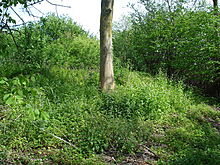|
|
|
|
Woolley Downs BarrowsBarrow / Cairn Cemetery
|
||||||||||||||||||||||||
|
|
|
Images (click to view fullsize) |
|


|
Fieldnotes |
|
| Situated on The A338 Wantage to Hungerford road by the turning to South Fawly there 3 barrows in total. The oldest is the believed to be from the late Bronze age and the larger 2 from the Iron age. The site is overgrown so i couldn't find the smaller of the 3 barrows. There is a footpath that runs past barrows so access is not a problem. |
11th May 2009ce |
Miscellaneous |
|
|
Three round barrows situated in the south-west corner of Woolley Downs, Chaddleworth, between the parish boundary and the Hungerford-Wantage road, were excavated in 1933. Barrows A and B were similar in construction, consisting of deep circular ditches, seventy and ninety feet in diameter respectively, the spoil being thrown up to form rings of rubble inside. No interments were found in A, but B. contained an empty pit near the centre and an undated secondary cremation in the chalk ring. Finds from A and B included Romano-British pottery, and sherds ranging throughout the Iron Age. Barrow C contained pottery fragments of both these periods plus one beaker sherd and several pieces of Early or Middle Bronze Age pottery. They may have been erected as early as 400 B.C. but more likely about the beginning of the Christian era. Their purpose, which was not determined, may not have been sepulchral. Associated occupation debris dates until the second century AD. [C.SU 3991 8046] Barrow C was quite different from A & B and appears to be a Late Bronze Age "scraped-together" barrow. Two empty pits were found beneath the barrow and a double inhumation burial, possibly Saxon, across the ditch. |
11th May 2009ce |

